In the world of websites, there’s a special number that tells a story – the average bounce rate. Imagine it as a digital trail left by visitors who decide to leave after just one glance. It’s like counting how many people walk into a store but decide to turn around and leave without looking at anything else. This bounce rate is calculated by figuring out the percentage of folks who do this compared to everyone who visits. It’s not just a number; it’s like a digital tale of what people do on a website.
Before we dive into the details of how this works for different types of websites, let’s quickly talk about two terms – bounce rate and exit rate. The average bounce rate counts the people who leave right after landing on one page, while the exit rate counts everyone who leaves, no matter how many pages they look at.
Now that we’ve got these terms in our pocket, let’s embark on an adventure to understand why bounce rate matters and how it dances differently across various kinds of websites. It’s like exploring different lands in the digital universe, where every click and exit adds a new chapter to the story of your online space. Join us as we decode the secrets of average bounce rate!
What’s the bounce rate?
The bounce rate is a metric that reveals the percentage of visitors who navigate away from a site after viewing only one page. Calculated by dividing the number of single-page visits by total visits, it offers insights into user engagement.
The calculation is extremely simple, the formula below will help you:
Bounce Rate = Single-Page Visits (Bounces) ÷ Total Visits (Sessions)
Exit Rate vs. Bounce Rate
It’s easy to confuse the exit rate with the bounce rate, which specifically measures the percentage of users who leave after a single-page view. In contrast, the exit rate considers the last page of a session, regardless of the number of pages viewed before leaving.
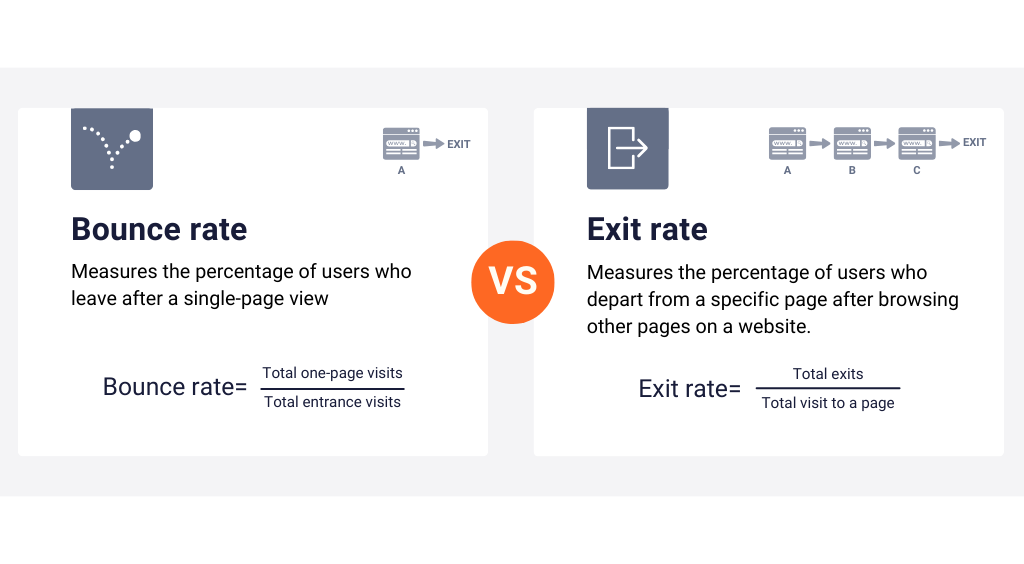
Why is bounce rate so important?
Understanding bounce rate is like using a compass in the vast digital landscape, leading you to valuable insights about visitor behavior on your website. If many visitors are leaving your site after only seeing one page, the compass signals that something might need attention. It’s like a friendly nudge saying, “Hey, take a look here – users might not be finding what they’re looking for.”
Now, let’s address the big question: Is a high average bounce rate always a cause for concern? Well, not necessarily. It’s a bit like looking at a map. If you’re on a website with a single-page purpose, like a recipe site where visitors come for one specific recipe, a high might not be a red flag.
People get what they need and leave, and that’s okay. On the flip side, if you have a multi-page site, like an online store, and a lot of visitors are bouncing, it could be a sign that something isn’t quite clicking – maybe your content is off, or your site is hard to navigate.
So, the average bounce rate isn’t a one-size-fits-all metric; it’s more like a personalized guide telling you what’s working and what might need a little digital TLC. It’s your compass to better understand how visitors interact with your online space.
What’s a good bounce rate?
Figuring out the perfect bounce rate is akin to finding the right beat for different songs – it’s not the same for every tune. This ideal metric is not a general concept. Imagine it as a flexible ruler, bending and shaping itself based on your website’s unique features.
The optimal bounce rate for a website really depends on the purpose it serves. The ambition is common to all of us: to achieve the lowest possible bounce rate. Realistically, however, the average bounce rate for a website will probably always be somewhere around or above 50%. It is therefore important not to focus on the average, but to take the time to look at the bounce rates of individual sites. Identify and reduce those that are the most problematic or cause the greatest financial loss to your business.
What’s the average bounce rate?
The average bounce rate ranges between 26% and 70% regardless of the industry. However, a bounce rate between 26% and 40% is considered very good. According to BusinessDIT, the average bounce rate regardless of industry is 55.43%. For e-commerce websites, the average bounce rate is around 47%, while for blogs, the average bounce rate can be as high as 70-90%.
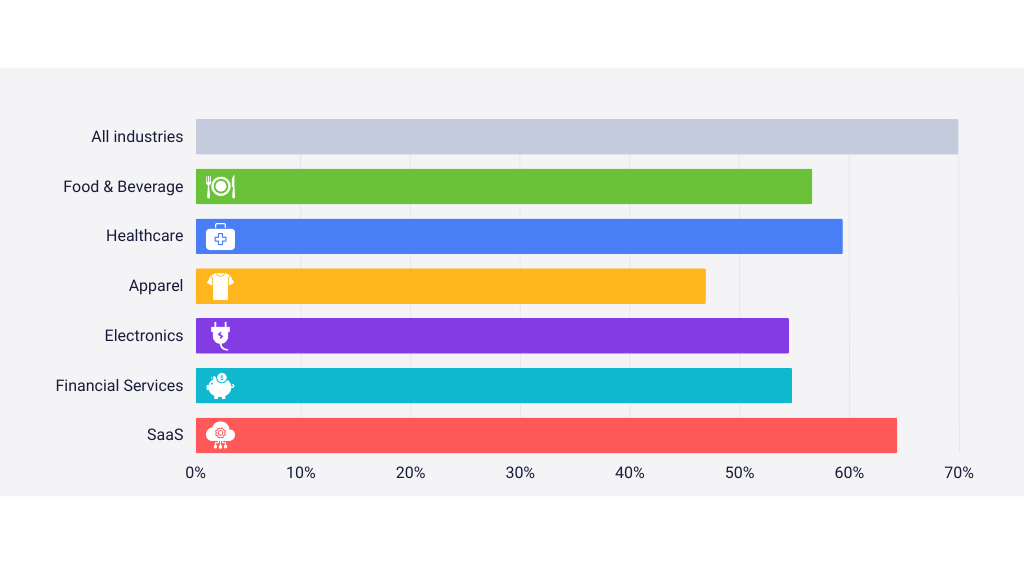
So, why isn’t there a universal “ideal” bounce rate?
Well, each online space has its own story to tell. Different industries have different norms, and what works for one might not quite click for another. If you’re running a news site where readers pop in for a quick update, a higher bounce rate might be all right – they got what they came for. On the flip side, if your website is all about getting visitors to explore multiple pages, like an entertainment site, a lower bounce rate might be the goal.
Understanding that not every dish needs the same amount of spice – you adjust based on the flavor you’re aiming for. Similarly, the ideal average bounce rate adjusts based on what your website serves up. As we step into the world of industry-specific averages, keep in mind that this metric isn’t a strict judge; it’s more like a friendly coach, helping you score a winning game in the digital arena. So, let’s explore how bounce rates waltz differently in various digital landscapes and uncover the unique rhythms of different online domains.
Benchmark average bounce rate by industry
Welcome to our exploration into the digital world, where we’re about to peek into some important industries and see how bounce rates – a fancy term for how quickly people leave a website – play out in these online realms.
Analyzed industries:
- Food & Beverage,
- Healthcare,
- Apparel,
- Electronics,
- Financial Services,
- and SaaS (Software as a Service).
Why Does It Matter?
Think of it this way: when you visit a website, do you stick around and explore, or do you leave right away? That decision is what we call a bounce, and it tells us a lot about how people engage with a website. Now, why does this matter for industries like Food and Beverage, Healthcare, Apparel, Electronics, Financial Services, and SaaS?
Each of these is a unique corner of the internet where people do different things – from ordering food online to learning about health tips or exploring the latest gadgets. By looking at bounce rates, we can uncover patterns and understand why people might stay longer in some digital places and quickly click away in others.

Food & Beverage Industry
Let’s pull up a chair and dive into the digital realm of the Food and Beverage industry, where the bounce rate – the speed at which visitors exit a website – paints a unique picture. In 2023, the average bounce rate in the Food and Beverage sector stood at 56.62%.
Now, if we take a glance at the overall industries, the median bounce rate in the Food and Beverage industry is slightly higher at 60.78%, as per the Databox study. Surprisingly, the Food & Beverage industry lags with a lower turnaround rate compared to the broader spectrum of industries studied. However, another study presents a slightly different figure, citing a bounce rate of 65.52%.
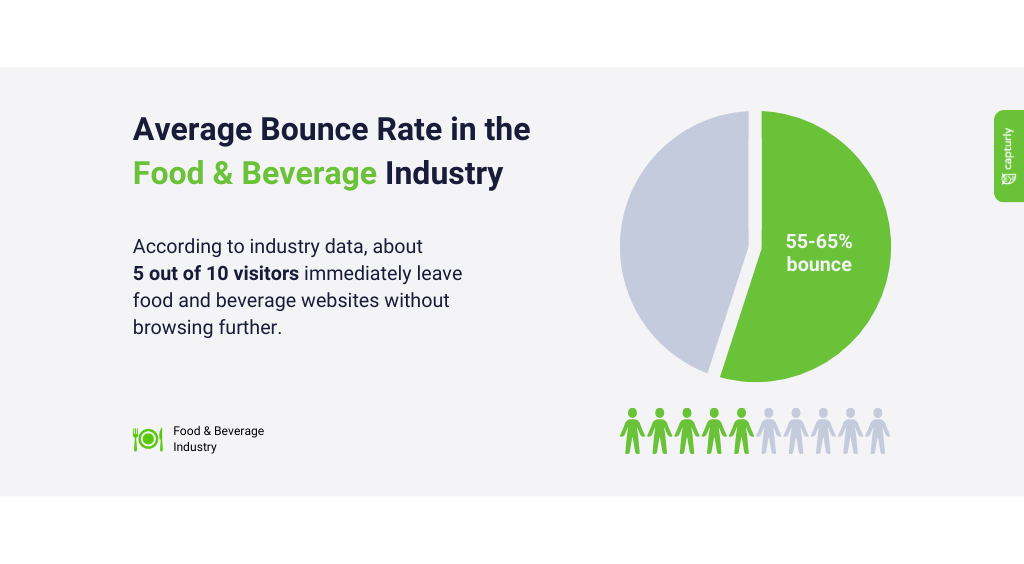
So, why might the Food and Beverage industry have a higher bounce rate compared to the median? One significant reason could be the nature of restaurant websites. Many of these sites offer straightforward information about location, hours, and contact numbers. Users might quickly bounce after gathering this essential information, leading to a higher bounce rate. Essentially, these websites serve their purpose efficiently but don’t necessarily encourage users to linger.
But what other ingredients could be contributing to this trend? Perhaps the visual appeal of the website, the menu presentation, or the lack of interactive elements might be at play. In the food world, presentation matters, not just on the plate but also on the digital menu. As we continue our culinary journey into the digital landscape, we’ll explore these potential factors that influence bounce rates in the Food & Beverage industry. So, grab a digital fork, and let’s uncover the flavors of online engagement in this bustling sector.

Healthcare Sector
Now, let’s shift our focus to the Healthcare sector, a digital space where information can be critical, and user engagement takes on a different shade. In 2023, the average bounce rate for healthcare websites stands at 58.29%, as reported by Oberlo. Databox, another reputable source, closely echoes this finding with a rate of 59.44%. These studies align closely, providing a consistent view of bounce rates in the Healthcare sector.
But what might be behind this relatively moderate bounce rate? One key aspect is the nature of healthcare content. Visitors to healthcare websites often seek specific information, and if they find what they need swiftly, they might not linger for an extended period. Additionally, the trust factor plays a crucial role. Users want reliable and accurate health information, and once they obtain it, they may exit the website.
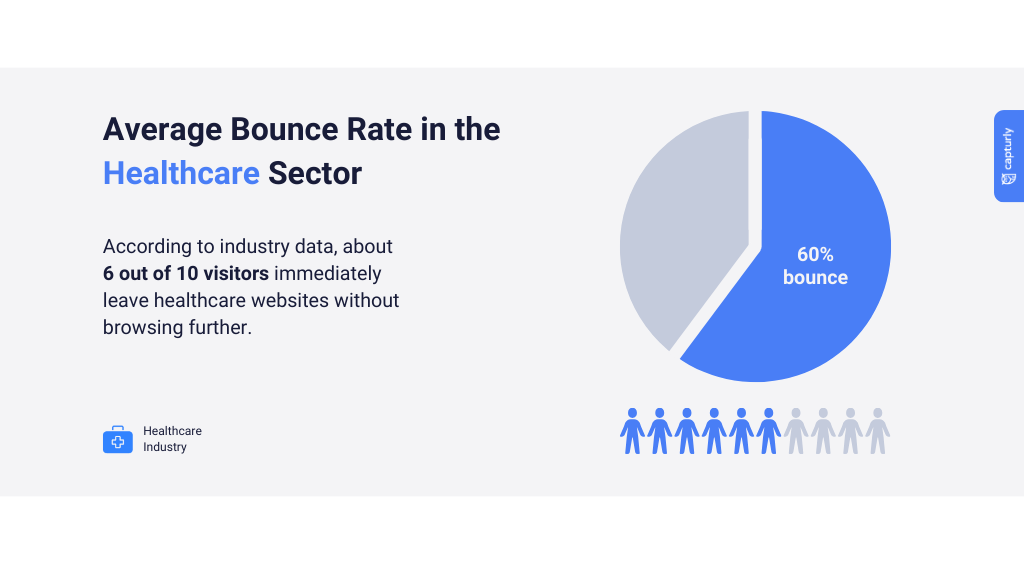
Now, let’s talk about the elephant in the room – the effects of the COVID-19 pandemic. The healthcare landscape experienced significant changes during this period. With increased reliance on digital platforms for health-related information, the average bounce rate might have been influenced by the urgency of finding pandemic-related information and the shift in user behavior during this time.
But what other factors contribute to this bounce rate in the Healthcare sector? The complexity of medical content, the potential lack of interactive elements, and the need for mobile responsiveness could also impact user engagement. As we explore further into the healthcare digital realm, we’ll dissect these potential reasons and unveil the unique dynamics shaping bounce rates in this critical sector.

Apparel Industry
Now, let’s step into the stylish world of the Apparel industry, where bounce rates take on a graceful rhythm. In 2023, the average bounce rate for apparel websites exhibited an impressive performance. According to the CXL study, it stands at 45.68%, and Databox closely aligns with a rate of 46.97%. Notably, these figures position the Apparel sector with one of the lowest bounce rates, approximately 14% below the median across industries.
Why does the Apparel industry showcase such bounce rate elegance? One key factor is the visual appeal inherent in fashion and clothing websites. These platforms often prioritize captivating visuals, enticing users to explore various products and collections. The nature of the content encourages users to browse, creating an engaging experience that keeps bounce rates relatively low.
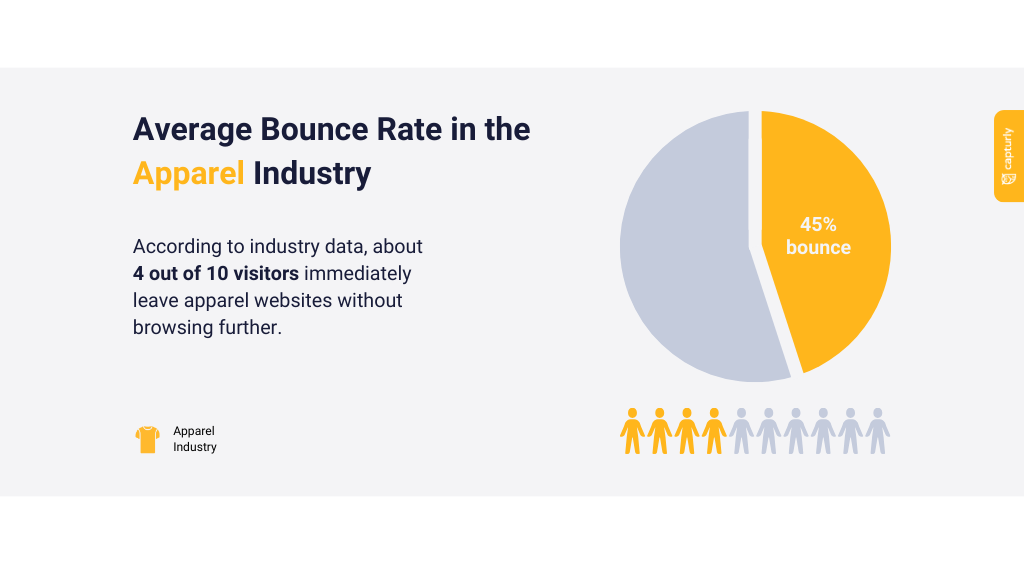
The appeal of online shopping and the desire to explore different styles might contribute to visitors spending more time on these websites. Additionally, the competitive landscape of the apparel industry encourages businesses to design websites that not only showcase products but also create an immersive brand experience.
As we thread our way through the digital runway of the Apparel industry, we’ll continue unraveling the reasons behind these impressive bounce rate numbers. From visual storytelling to the allure of the latest fashion trends, each element contributes to the captivating dance of user engagement in the online fashion world.

Electronics Industry
Let’s venture into the dynamic world of Electronics, where the average bounce rate in 2023 sparks at 54.54%. Why? It’s like this digital realm is powered by the very devices it showcases – swift, efficient, and leaving users plugged in for more. In the electronic playground, users often dive in with a specific purpose – whether researching the latest gadgets, comparing features, or hunting for tech solutions.
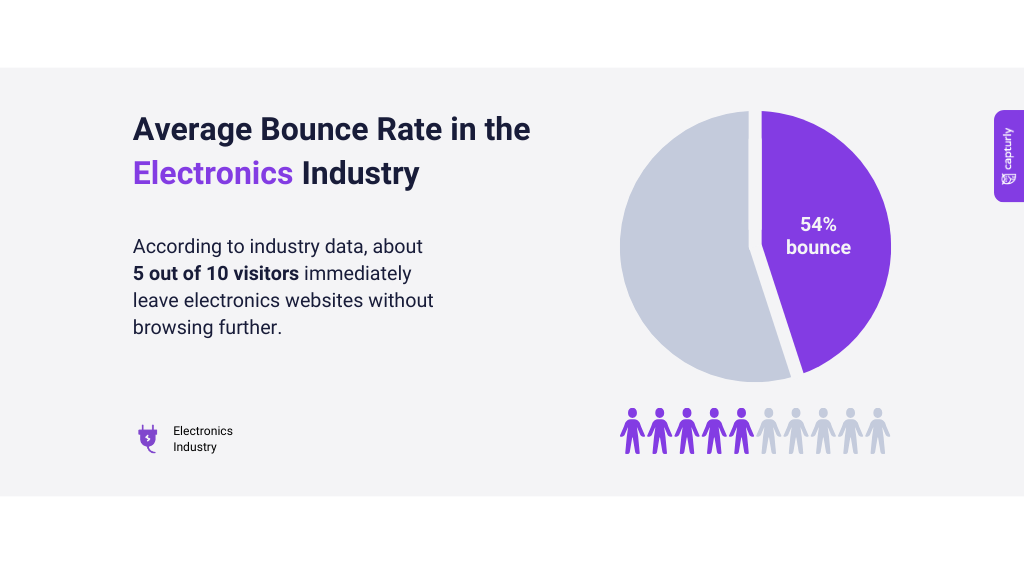
They want information, specs, and perhaps a glimpse of the next groundbreaking innovation. Once they’ve got what they came for, they’re out, ready to conquer the digital landscape with newfound tech knowledge. It’s a swift dance of engagement, where the bounce rate reflects the efficiency of users finding what they need at the speed of digital light.

Financial Services Industry
In the intricate realm of Financial Services, the digital compass reveals an average bounce rate of 51.71% in 2023. What’s steering this digital ship, you wonder? Think of it as a financial dash; users come aboard for precise information, whether it’s understanding interest rates, exploring investment avenues, or navigating financial tools.
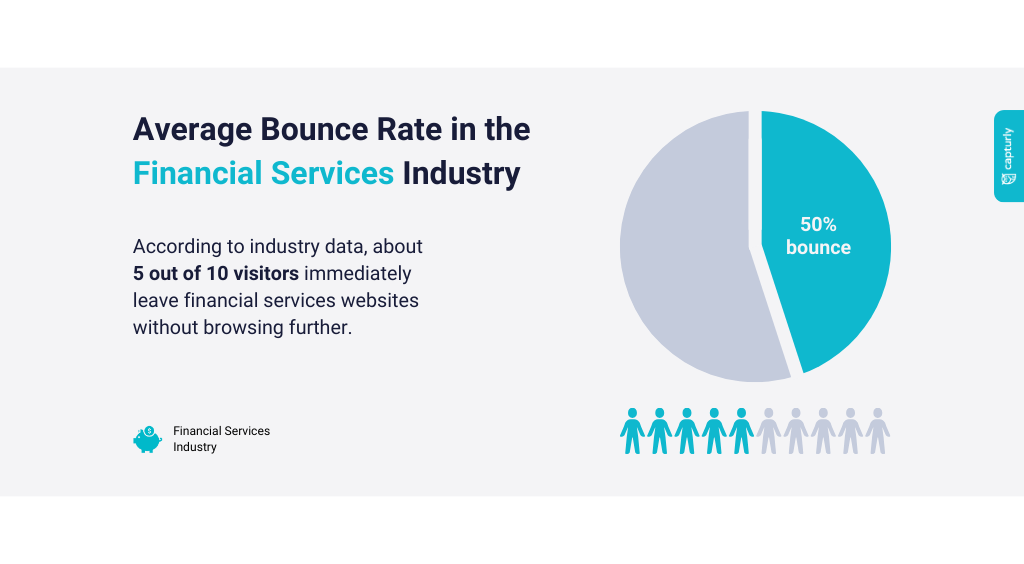
The financial landscape operates on a different wavelength. Users seek swift answers in this digital financial maze, and once they’ve secured the financial insights they crave, they gracefully exit the virtual financial boardroom. The complex nature of financial content plays a role; it demands a different kind of engagement compared to visually-driven industries.
Moreover, financial services cater to a diverse audience, each with unique financial needs. This diversity orchestrates a symphony of clicks as users navigate through the digital financial terrain, searching for information that resonates with their distinct financial goals.

SaaS Industry
In the world of Software as a Service (SaaS), digital metrics paint an intriguing picture. According to Databox, the average bounce rate in SaaS for 2023 stands at 64.46%, ranking as the second highest in the study. Now, why might the SaaS landscape be resonating with this relatively high bounce rate?
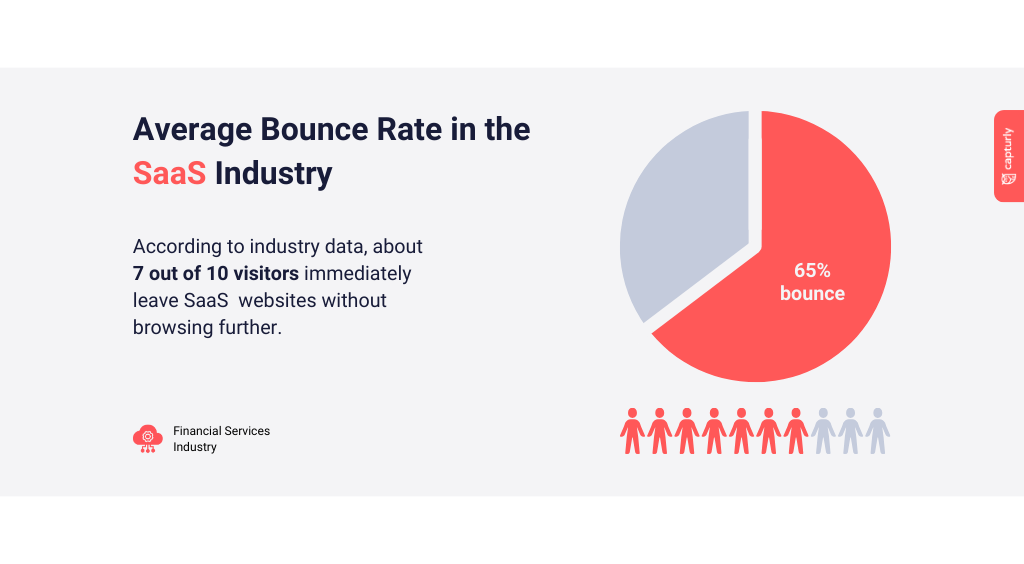
SaaS websites often serve a specific purpose – users visit with a clear intent, whether it’s exploring software features, seeking solutions to a particular challenge, or evaluating pricing plans. The nature of SaaS platforms requires users to dive into the functionalities swiftly. Once they’ve gathered the necessary information or found what they’re looking for, users might exit without extensive exploration.
Additionally, the competitive nature of the SaaS industry might contribute to this bounce rate. Users often navigate through multiple SaaS websites, comparing features and pricing, leading to a higher likelihood of bouncing after a brief visit.
Reasons for a high bounce rate
Before we delve into the industry-specific landscape, let’s pinpoint the key factors that might be causing your bounce rate to soar.
- Slow Page Load Times: In today’s fast-paced digital world, users demand speed. If your website takes more than a few seconds to load, visitors are likely to bounce. Optimize images, leverage browser caching, and invest in a reliable hosting provider to keep your load times swift.
- Unappealing Design: First impressions matter, especially in the digital realm. If your website sports an outdated or confusing design, users might not stick around. Invest in a modern, user-friendly design that aligns with your brand and makes navigation a breeze.
- Irrelevant Content: Content is king, but only if it’s relevant. If visitors don’t find what they’re looking for, they’ll bounce. Conduct thorough keyword research, understand your audience’s needs, and craft content that provides genuine value.
- Poor Navigation: Your website’s navigation should be as intuitive as possible. Complicated menus and confusing structures can frustrate users, prompting them to exit. Streamline your navigation, use clear labels, and ensure visitors can easily find their way around.
Now, let’s take a journey through various industries, examining how average bounce rates have evolved.
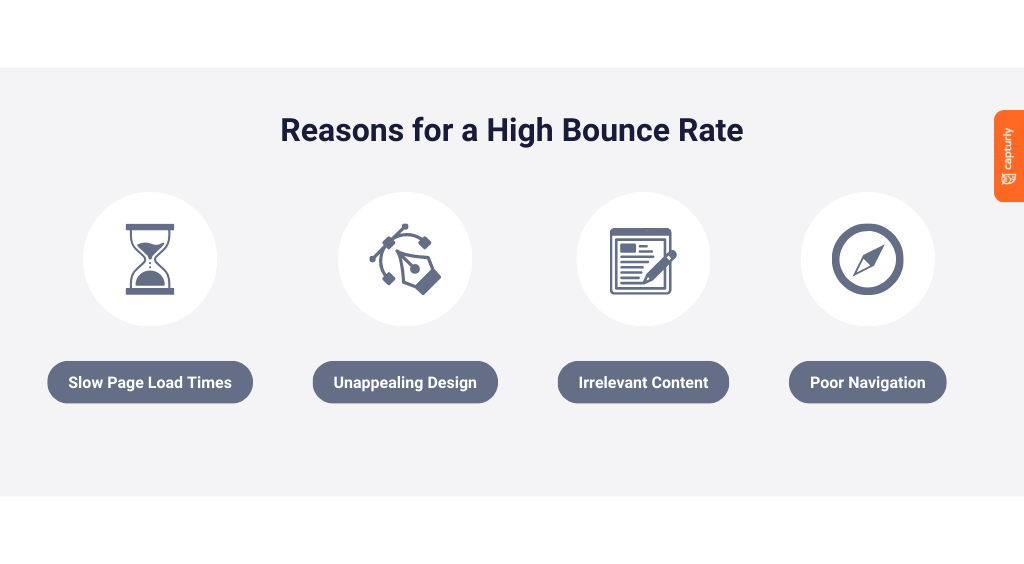
How to reduce the bounce rate on your website
Now that we’ve taken a stroll through the world of average bounce rates across different digital realms, let’s dive into actionable steps to dial down this metric and boost user engagement.
1. Optimize Page Load Speed
In the race through the digital highway, speed is your trusty steed.
To keep visitors from hitting the brakes and bouncing away, focus on:
- Compressing Images: Like shrinking the file size of your digital snapshots to speed up loading times.
- Leveraging Browser Caching: Allowing repeated visitors to experience faster load times by storing some information in their browsers.
- Minimizing Server Response Time: Picking a reliable hosting provider to ensure your digital home responds swiftly to user requests.
2. Improve Website Design
Think of your website as a cozy home for digital travelers.
Ensure it’s inviting and easy to navigate by:
- Prioritizing User-Friendly Layouts: Crafting designs that welcome users with open arms, making navigation a breeze.
- Ensuring Mobile Responsiveness: In a world glued to smartphones, guarantee your site looks and works seamlessly across various devices.
3. Create Relevant and Engaging Content
Picture your content as a conversation starter at a digital gathering.
To keep visitors tuned in, consider:
- Audience Research: Delving into the interests and needs of your audience to tailor content that resonates.
- Clear Call-to-Actions (CTAs): Guiding users with crystal-clear prompts that entice them to explore further, reducing the likelihood of bouncing.
4. Enhance Navigation
Navigating your website should be as straightforward as following a treasure map.
Make the journey enjoyable by
- Simplifying Menus: Like creating road signs that guide users without confusing detours.
- Utilizing Internal Linking: Strategically placing links to related content, encouraging users to extend their stay.
Reducing bounce rates isn’t a sprint; it’s a marathon of continuous improvement. Regularly analyze user behavior, adjust your strategies, and fine-tune your digital home. By embracing these practical tips, you’ll not only invite users to linger but also turn your digital space into a welcoming hub that beckons them to explore further. So, gear up, implement these steps, and watch your bounce rates take a pleasant nosedive!
Conclusion
Navigating the digital landscape involves understanding the nuances of bounce rates within specific industries. By benchmarking against the industry and implementing practical improvement tips, businesses can enhance user engagement and foster a more successful online presence.
In the world of digital marketing, mastering the art of balancing bounce rates is not just a metric – it’s a strategy for sustained success. So, keep an eye on your numbers, adapt to changing trends, and watch your online presence thrive.
Don't forget, sharing is caring! :)

![Average Bounce Rate by Industry 2023 [Benchmarks]](https://capturly.com/blog/wp-content/uploads/2023/11/Average-Bounce-Rate-by-Industry-2023-Benchmarks.png)